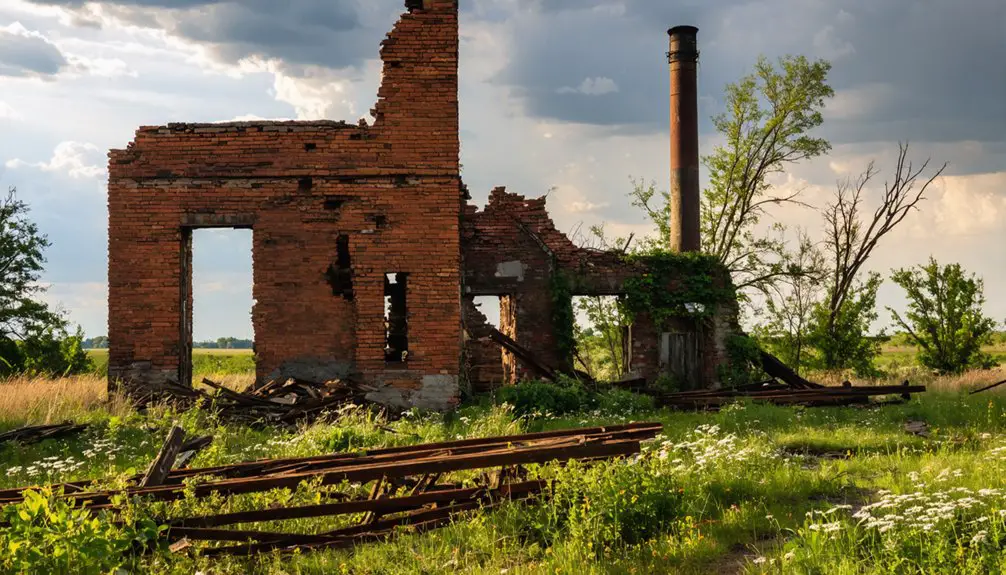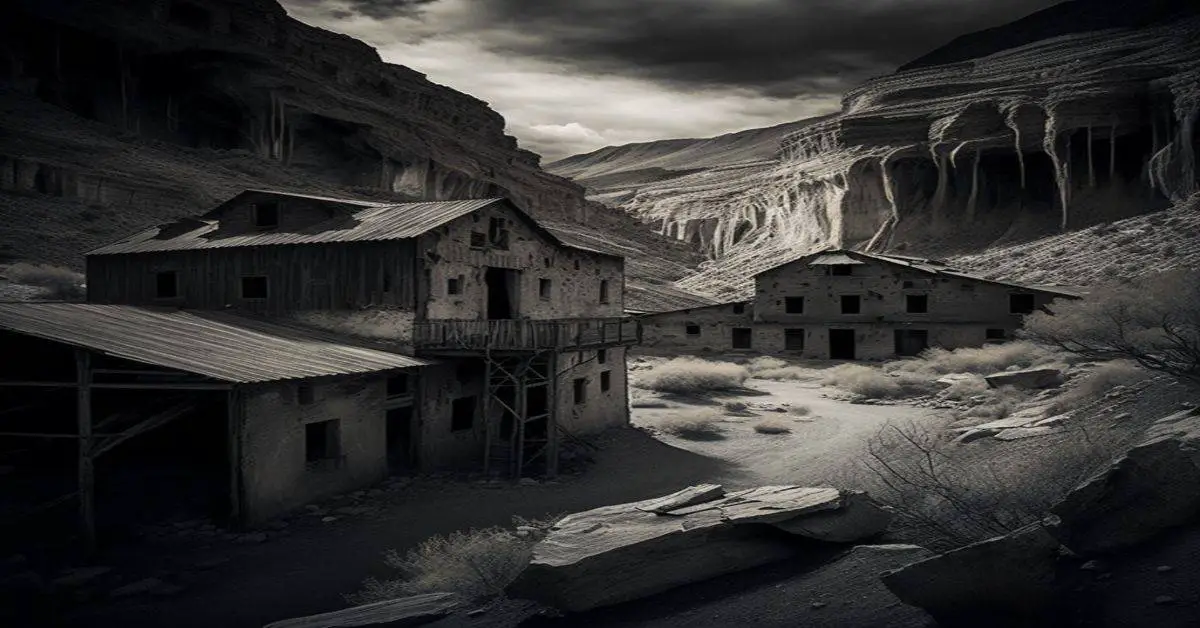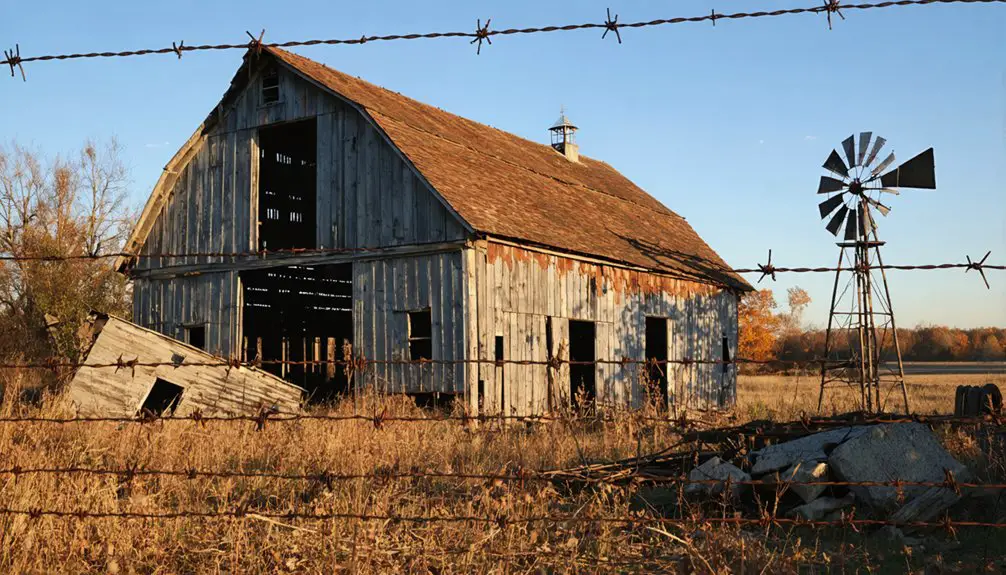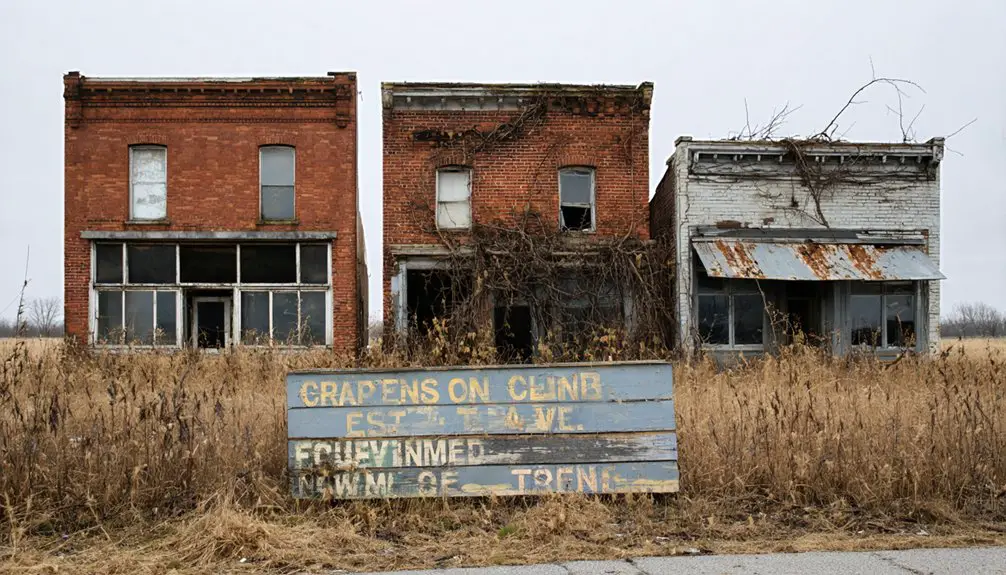You’ll find San Toy‘s haunting remains in Bearfield Township, Ohio, where a bustling coal mining town of 2,000 residents once thrived. Founded in 1902 by the New England Coal Company, it became notorious during Prohibition for moonshine production and lawlessness. After the Sunday Creek Coal Company’s takeover in 1915, San Toy flourished until the Great Depression hit. By 1931, the town was formally abandoned, though its dramatic tales of shootouts, bootleggers, and immigrant miners still echo through the hills.
Key Takeaways
- San Toy was a thriving Ohio coal mining town founded in 1902 that became abandoned by 1931 following mine closures.
- The town’s population peaked at over 2,000 residents but dramatically declined to just 128 by 1930.
- During Prohibition, San Toy became notorious for moonshine production and violent confrontations between bootleggers and law enforcement.
- The Sunday Creek Coal Company’s closure of Poston No. 6 mine in 1945 marked the final blow to San Toy’s existence.
- Today, only about 50 residents remain in the area, with abandoned structures and mining remnants marking the ghost town’s location.
The Birth of a Mining Town
When the New England Coal Company sought to establish a new mining operation in 1902, they founded San Toy in southeastern Bearfield Township, Perry County, Ohio.
Located in the heart of the Hocking Valley coal fields, the town’s strategic position near the Toledo & Ohio Central Railroad made it ideal for community formation and coal transport.
The economic foundations of San Toy were firmly rooted in coal mining, with the company developing essential infrastructure to support their operations. Much like the successful theater run of its namesake musical in London, the town experienced remarkable growth in its early years.
The town’s carefully designed layout included housing for miners and their families, reflecting the era’s typical company town model that would shape life for over 2,000 residents at its peak.
You’ll find that this planned settlement grew rapidly after the Sunday Creek Coal Company‘s takeover in 1915, expanding both mining operations and community facilities.
The company’s success was short-lived, as operations were terminated in 1927 when the Sunday Creek Coal Company closed its doors.
A Thriving Coal Community
Three distinct features defined San Toy’s thriving period: its booming coal economy, vibrant immigrant workforce, and notorious reputation for lawlessness.
During its peak, you’d have found over 2,000 residents working in the Sunday Creek Coal Company’s advanced mining operations, equipped with mechanical aids and sophisticated coal-handling facilities. The miners joined the Knights of Labor organization to fight against unsafe conditions and low wages.
San Toy’s bustling mines employed thousands, showcasing industrial innovation through state-of-the-art equipment and advanced coal processing systems.
The town’s cultural diversity flourished as immigrant laborers arrived, contributing to a dynamic community marked by both resilience and conflict.
You’d have witnessed frequent shootouts and criminal activity, while also seeing remarkable community resilience during economic hardships.
When Prohibition hit, residents adapted by running moonshine operations, defying both law enforcement and the Ku Klux Klan.
Despite the harsh realities of mining life, including deadly accidents and widespread armed robberies, San Toy’s tight-knit population demonstrated unwavering self-reliance.
Life in the Wild West of Ohio
Despite its location in Ohio, San Toy earned a reputation that rivaled the wildest towns of the American frontier. The town’s social dynamics reflected intense community resilience amid frequent shoot-outs, shotgun ambushes, and armed robberies that plagued its streets.
You’d find a complex mix of entertainment and danger in San Toy, where:
- A deadly love triangle erupted into a three-way shootout, exemplifying the town’s volatile nature.
- The county’s only hospital treated victims of regular bar brawls and street fights.
- Rival law enforcement officers, including a town marshal and prohibition agent, struggled to maintain order.
Despite the violence, residents built a vibrant community life centered around their theater and baseball team, proving that even in the roughest circumstances, people found ways to forge meaningful connections. The town’s lawless atmosphere was further demonstrated when thirteen men were crammed into the small local jail during one notable incident. When the mines closed in 1924 due to a labor dispute and fire, the town began its slow descent into abandonment.
Bootleggers and Law Enforcement
You’ll find that San Toy’s vibrant bootlegging scene during Prohibition centered around hidden stills and illicit moonshine operations, which flourished amid the town’s multiple bars and saloons.
Law enforcement faced considerable challenges controlling the illegal alcohol trade, as evidenced by their overtaxed jail cells and daily reports of violence in the streets. The town’s seven active saloons contributed significantly to its lawless reputation.
The frequent shootouts between lawmen and bootleggers, combined with the broader unrest from mining disputes, contributed to San Toy’s reputation as Ohio’s own slice of the Wild West. After the Sunday Creek Coal Company ended mining operations in 1927, many desperate residents turned to bootlegging as their primary source of income.
Moonshine During Prohibition Era
When San Toy’s coal mines shuttered around 1921, leaving 95% of residents unemployed, the community turned to moonshining as an essential means of economic survival.
The harsh reality of coal mining economics pushed families toward illegal distilling to support themselves amid widespread hardship and exploitation. Many miners had previously resorted to making moonshine to supplement their meager mining wages even before Prohibition. The spring water source made the area ideal for producing quality moonshine.
You’ll find San Toy’s moonshine operations were part of a broader resistance against Prohibition, reflecting the community’s determination to persevere.
Consider these key aspects of the local moonshine trade:
- Over 10,000 stills operated throughout Ohio, with San Toy becoming a significant producer.
- Local law enforcement faced fierce opposition from residents protecting their economic lifeline.
- External groups like the KKK attempted to suppress moonshining through intimidation, but the community’s resolve remained unbroken.
Shootouts Between Law Officers
The clash between bootleggers and law enforcement in San Toy mirrored the broader pattern of armed confrontations throughout rural Ohio during Prohibition.
While specific shootout incidents in San Toy aren’t directly documented, the region’s law enforcement tactics evolved in response to dangerous encounters with armed criminals.
You’ll find that throughout Miami County and surrounding areas, officers faced increasingly dangerous situations when confronting suspects. A notable 1972 incident saw Sergeant William R. Morris killed during a vehicle theft response, highlighting the lethal risks officers encountered. High-speed pursuits often reached speeds of 65 mph as suspects attempted to evade capture.
Typical encounters often escalated into barricaded standoffs, with suspects taking cover in farm buildings and continuing to exchange gunfire with police.
These confrontations shaped how law enforcement approached criminal pursuit, especially in isolated rural communities where backup could be far away.
Hidden Stills and Raids
During Prohibition, San Toy’s rugged terrain and abandoned mine infrastructure provided ideal cover for an extensive network of hidden stills, transforming the struggling coal town into a moonshine production hub.
With 95% unemployment following mine closures, residents turned to hidden distillation to survive.
Bootlegger tactics evolved to outmaneuver law enforcement and Klan opposition:
- Moonshiners strategically relocated their operations throughout the hills
- Community members protected bootleggers from Marshal Reid and Officer Nelson
- Smaller, mobile stills replaced larger operations to avoid detection
Despite fierce raids by Prohibition agents, San Toy’s underground alcohol economy persisted.
You’ll find that the town’s defiant spirit of self-reliance, coupled with economic necessity, kept the stills running even as law enforcement intensified their crackdowns through the era.
The Sunday Creek Coal Company Era
In September 1929, Sunday Creek Coal Company acquired Poston No. 6 mine, marking a significant shift in San Toy’s mining operations.
The historic Poston No. 6 mine changed hands in 1929, as Sunday Creek Coal Company took control of San Toy’s vital operation.
As the world’s second-largest coal corporation, Sunday Creek brought significant changes, immediately suspending operations to implement extensive infrastructure upgrades including brick walls, steel I-beam supports, and improved ventilation systems.
You’d have seen conventional mining techniques in action – coal-cutting machines resembling giant chainsaws and explosive charges breaking coal loose for manual loading.
The mine’s workforce, drawn from nearby company towns like Millfield and Glouster, faced ongoing labor disputes. While Sunday Creek provided extensive town infrastructure, mounting labor costs and stagnant coal prices eventually led to the mine’s permanent closure in May 1945, leaving behind a legacy that’s now preserved in the National Register of Historic Places.
The Great Exodus
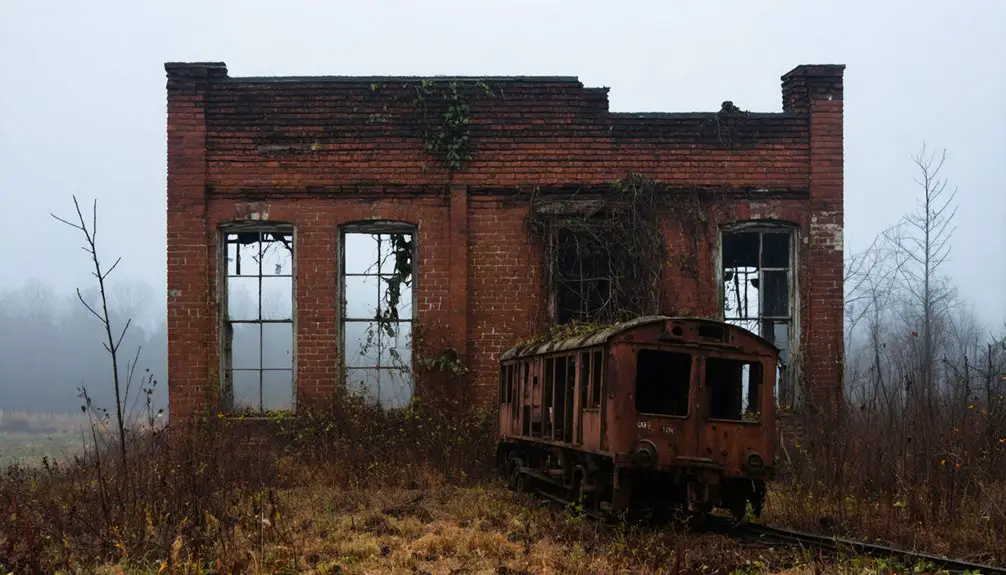
In San Toy’s most dramatic transformation, you’d witness the town’s population plunge from 976 to just 128 residents between 1920 and 1930 – marking the steepest per capita decline in the entire United States according to census records.
After the Sunday Creek Coal Company shuttered operations in 1927, you’d find unemployment soaring to 95% as families desperately sought work elsewhere.
The town’s fate was sealed when 17 of the 19 remaining registered voters cast their ballots to officially abandon San Toy in 1931, leaving behind only scattered remnants of what was once a bustling coal community.
Population Plummets After 1920
San Toy’s thriving population of 976 residents in 1920 plummeted to a mere 128 by 1930, marking the most dramatic per capita population drop in America at that time.
This staggering population decline of 87% reflected the harsh realities facing this once-bustling mining community.
You’ll find the devastating impact of this exodus reflected in these stark numbers:
- By 1931, only 19 registered voters remained
- 17 of those voters chose to officially abandon the town
- Today, just 50 people inhabit the former San Toy area
The community abandonment stemmed from multiple pressures: the post-mining economic downturn, the Great Depression’s grip, and recurring environmental challenges like floods.
Young residents fled to urban centers seeking better opportunities, leaving behind a ghost town that would serve as a reflection of industrial boom-and-bust cycles.
Coal Town Survival Fails
While many coal towns faced economic hardship in the 1920s, the collapse of San Toy proved particularly swift and devastating after the Sunday Creek Coal Company shuttered its mines in winter 1921.
You’d have witnessed a staggering 95% unemployment rate as the town’s economic lifeblood vanished overnight.
San Toy’s lack of economic diversification sealed its fate. Without alternative industries or businesses to sustain the community, you’d have seen desperate residents turn to moonshining and other illicit activities to survive.
The town’s limited infrastructure and dwindling public services couldn’t support community resilience. By 1931, the situation had become so dire that 17 out of 19 remaining voters chose to formally abandon the town, marking the end of San Toy’s brief but turbulent existence.
Traces of a Forgotten Past
Today’s visitors to the former coal mining town of San Toy encounter a landscape marked by silent witnesses to its tumultuous past.
If you explore the site, you’ll find forgotten relics scattered throughout: visible building foundations, traceable street patterns, and remnants of mining infrastructure that tell the story of this once-bustling community.
The area’s cultural heritage lives on through:
- Local residents who maintain the stories of epic moonshine operations and wild shootouts
- Historical photographs and documents preserved by dedicated folklorists
- The very landscape itself, where approximately 50 people still make their homes among the ghostly traces
Nature slowly reclaims the town’s physical remains, but San Toy’s legacy endures through both its tangible remnants and the vivid tales of its colorful past.
San Toy’s Impact on Ohio History
During the early twentieth century, the coal mining town of San Toy left an indelible mark on Ohio’s industrial and social landscape.
You’ll find its legacy reflected in the broader story of Ohio’s volatile coal industry and the challenges faced by company-owned towns. San Toy’s dramatic economic decline, from a bustling community of 2,500 to virtual abandonment by 1931, serves as a cautionary tale about the risks of single-industry dependence.
The town’s cultural legacy lives on through local folklore, including tales of its “wild west” atmosphere and the sheriff who once jailed thirteen men simultaneously.
Today, you can trace San Toy’s influence in Perry County’s historical narrative, regional mining policies, and labor relations. Though the town has vanished, its story continues to shape discussions about sustainable community development in Ohio’s mining regions.
Frequently Asked Questions
Why Was the Unusual Name “San Toy” Chosen for This Ohio Town?
You’ll find the unusual origin of “San Toy” remains mysterious, though its historical significance likely stems from popular Asian-themed entertainment or coal company marketing during the town’s 1902 incorporation.
What Happened to the Buildings and Homes After the Town Was Abandoned?
You’ll find most abandoned structures deteriorated without maintenance after residents left – wooden homes rotted away, while fires and neglect destroyed others. Today only foundations remain, with minimal historical preservation efforts.
Did Any Families From San Toy’s Peak Period Remain in the Area?
You’ll find no documented family descendants from the peak mining era still living there today. Local memory and records show nearly everyone left by 1931, with new residents moving in later.
What Was the Average Wage for Coal Miners in San Toy?
You’ll find coal miner wages were considerably depressed during this period, with workers earning well below today’s standards. Exact figures aren’t documented, but economic conditions forced many miners to supplement through moonshining.
Were There Any Schools or Churches Established During the Town’s Existence?
You won’t find any clear records of schools or churches in the town’s history. While these institutions were common in mining communities, historical documents don’t mention their establishment or significance here.
References
- https://curtyehnert.wordpress.com/2016/08/07/first-blog-post/
- https://en.wikipedia.org/wiki/San_Toy
- https://ohioghosttowns.org/perry-county/
- https://media.library.ohio.edu/digital/collection/buhla/id/434/
- https://www.ghosttowns.com/states/oh/santoy.html
- https://dam.assets.ohio.gov/image/upload/ohiodnr.gov/documents/geology/B72_Crowell_1995.pdf
- https://www.lcbdohio.org/history/
- https://www.youtube.com/watch?v=IMYfMz7mvlk
- https://ohioghosttowns.org/top-10-semighost-towns/
- http://www.myqualitytime.net/2010/06/not-all-that-far-from-lancasterohio-we.html
